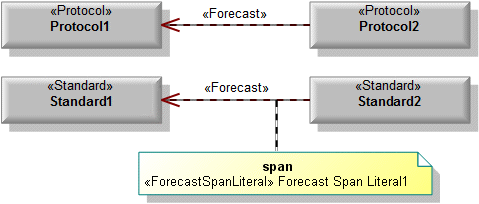TV-2 Standards forecast table (UPDM - MODAF aliases)

Creation
To create a TV-2 Standards Forecast Table:
• Right-click the
Architectural Description or
Service Description that is to own the TV-2 Standards Forecast Table, point to New, point to Matrix/Table, point to MODAF, and then click TV-2 Standards Forecast Table.
When you open a TV-2 Standards Forecast Table, Modeler can generate it as HTML for viewing in your Internet browser, or generate it as a spreadsheet for viewing in Microsoft Excel. To specify how matrices and tables are opened for a model: in the Packages pane, right-click the Model, point to > > , and then select HyperTextMarkupLanguage_HTML or Excel_XLS.
Each time you open a TV-2 Standards Forecast Table, Modeler generates the product using the latest data from the model.
Purpose
On a TV-2 Standards Forecast Table:
• Show
Functional Standard,
Protocol,
Standard and
Technical Standard elements from the analyzed Packages.
• View Functional Standard, Protocol, Standard and Technical Standard elements that are related through
Forecast relationships (as the source elements) to the shown Functional Standard, Protocol, Standard and Technical Standard elements.
• View the
Forecast Span Literal elements that define the span of the shown Forecast relationships.
Elements Shown

The TV-2 Standards Forecast Table shows the following elements:
• A row is created for each Functional Standard, Protocol, Standard and Technical Standard that is found in the analyzed Packages.
• When the Functional Standard, Protocol, Standard and Technical Standard for which the row has been created is the target of a Forecast relationship:
◦ A column is created for each Forecast Span Literal that specifies the span of that Forecast relationship.
◦ The name of the Forecast relationship's source element is shown in the Forecast Span Literal column.
◦ When no span is specified for the Forecast relationship, a column named [Undefined] is created.
◦ The name of the Forecast relationship's source element is shown in the [Undefined] column.
• If a column has been created for Forecast Span Literal, that column is used for all Forecast relationships that use that Forecast Span Literal. Only one [Undefined] column can be created in the table. • If a column is created for a Forecast Span's Forecast Span Literal, columns are also created for all of that Forecast Span's Forecast Span Literal elements, irrespective of whether they are used or not. |
Analyzed Packages
By default, the TV-2 Standards Forecast Table searches for Functional Standard, Protocol, Standard and Technical Standard elements that are contained within the Architectural Description or Service Description that owns the TV-2 Standards Forecast Table.
To search for Functional Standard, Protocol, Standard and Technical Standard elements from other Architectural Description and Service Description packages:
• Right-click the TV-2 Standards Forecast Table, point to Links, and then click Analyzed Packages. From the Links Editor, select the Architectural Description and Service Description packages from which you want to search for Functional Standard, Protocol, Standard and Technical Standard elements.
Example
In this example, the model is set up to generate tables and matrices as Excel spreadsheets. The Architectural Description that owns TV-2 Standards Forecast Table1 contains Standard1 and Protocol1. An Architectural Description that is not included in the analyzed Packages contains Standard2 and Protocol2. These elements are related as shown below, with Forecast Span Literal1 defining the span of the Forecast that links Standard1 and Standard2.
Note that to define the span of a Forecast: right-click the Forecast, point to Links, and then click Span.

When the Excel spreadsheet is generated for TV-2 Standards Forecast Table1, a row is created for Standard1 and Protocol1 because they are in the analyzed Packages.
 from the table you can see the following:
from the table you can see the following:• A Forecast relationship links Standard2 to Standard1. The span of this Forecast is defined through Forecast Span Literal1.
• A Forecast relationship links Protocol2 to Protocol1. The span of this Forecast is not defined.
The following sections provide information about how a TV-2 Standards Forecast Table is used in the model.
Create a TV-2 Standards Forecast Table from
Creates or shows these UPDM elements







